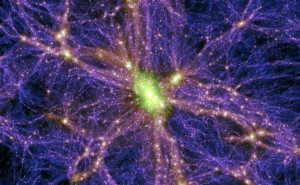Dark matter is material that gravitates but does not emit very much light. It is undetectable by its emitted radiation but whose presence can be inferred from gravitational effects on visible matter. Dark matter is postulated to explain the flat rotation curves of spiral galaxies and other evidences of “missing mass” in the universe. According to present observations of structures larger than galaxies, as well as big bang cosmology, dark matter and dark energy account for the vast majority of mass in the observable universe. The observed phenomena which imply the presence of dark matter include the rotational speeds of galaxies, orbital velocities of galaxies in clusters, gravitational lensing of background objects by galaxy clusters and the temperature distribution of hot gas in galaxies and clusters of galaxies. 
The dark matter component has much more mass than the “visible” components of the universe. At present, density of ordinary baryons and radiation in the universe is estimated to be equivalent to about one hydrogen atom per cubic meter of space. Only about 4% of the total energy density in the universe (as inferred from gravitational effects) can be seen directly. About 22% is thought to be composed of dark matter. The remaining 74% is thought to consist of dark energy, an even stronger component, distributed diffusely in space. Some hard to detect Baryonic matter is believed to make a contribution of dark matter but would constitute a small portion. Determining the nature of this missing mass on one of the most important problems in modern cosmology and particle physics.
The vast majority of dark matter in the universe is believed to be non-baryonic, which means that it contains no atoms and it does not interact with ordinary matter via electromagnetic forces. The non-baryobnic dark matter includes neutrinos which were discovered to have mass in recent years and may also include hypothetical entities such as axions or super-symmetric particles.






